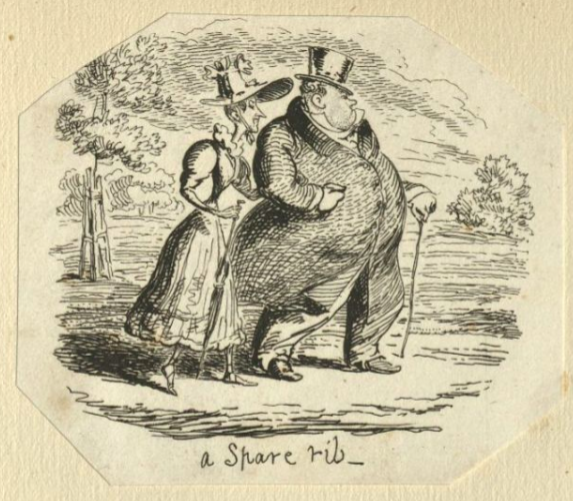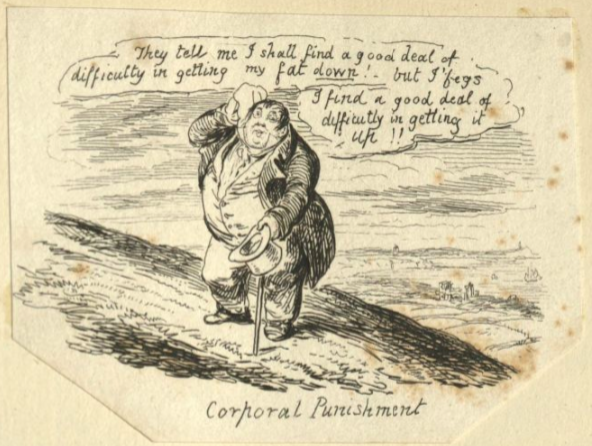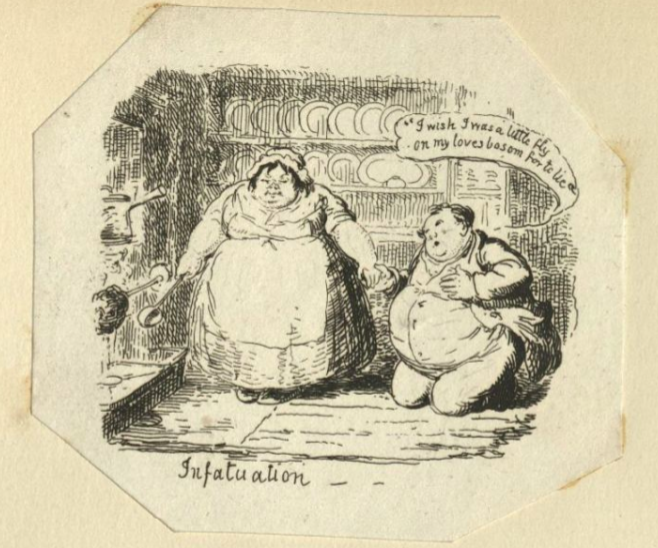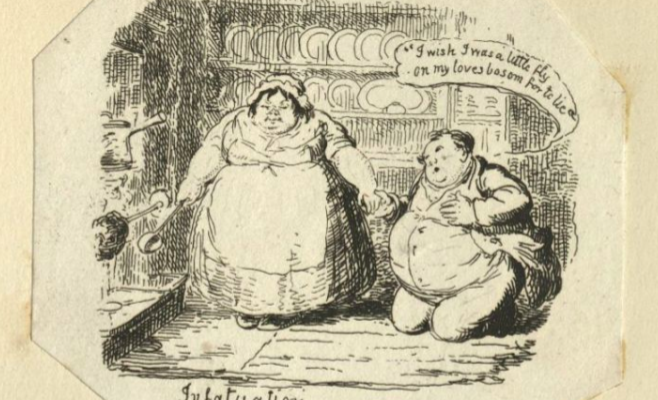By Mike Thompson

From the 19th century to the 21st century, the topic of obesity has been discussed and portrayed by writers and artists in a variety of ways, both positively and negatively. Although obesity remained a marker of class status (specifically upper-class) from ancient times until the 19th century, some readers might be surprised to find out how attitudes toward these topics from the 19th century compare to our modern understanding of obesity and class. This black and white plate, titled “A Spare Rib,” comes from an undated bound book of George Cruikshank illustrations. It depicts an obese man wearing a coat and top hat accompanied by a much thinner woman who is wearing a hat and dress holding onto his arm as she uses her umbrella for a walking stick. They both look forward as the obese man leads the way with his hat tilted toward the front of his head, giving him a determined yet doltish presentation. They appear to be walking on a paved path with an open field behind them, blemished only by a thin tree being held up by stilts. The paved path that they’re walking on and the human-cultivated sapling behind them suggest that they are in a park. Because of their refined style of dress and the visual queues that show them to be in a park rather than the wilderness or the market, it is likely that they are a bourgeois couple out for a Sunday promenade.
The joke being made by George Cruikshank in this piece is in reference to the Adam and Eve narrative that opens Genesis, in which God created Eve from one of Adam’s ribs. In addition to the biblical reference, spare ribs are also a popular meal that is associated with poor health and obesity. The woman being carried on the man’s arm in this plate is the “spare rib” – a figure so skinny that George Cruikshank is comically suggesting she could have been crafted from the excess of the man’s obese body. It is also noticeable that she walks a step behind the obese man while holding onto his arm, clearly placing her in a submissive role that fits with the patriarchal themes found in the Adam and Eve narrative to which George Cruikshank is alluding.
This anti-obesity theme can be seen in other etchings by George Cruikshank, such as the following plate titled “Corporal Punishment” from the same bound book of illustrations:

In this plate, George Cruikshank is making another ironic joke about the difficulty of losing weight and “getting it up,” or exercising, which is the means of losing it. Again, this obese man is depicted with a coat, top-hat, cane, and handkerchief – all markers of his class status as a bourgeois gentleman in 19th century British society. It’s notable too that George Cruikshank draws him walking up a hill, like a Victorian Sisyphus pushing his boulder of a body higher and higher with no end in sight, underscoring even more the irony of his dilemma. George Cruikshank’s dislike of obesity is not reserved exclusively for the upper classes, however. The following plate, satirically titled “Infatuation,” depicts an obese working class man eagerly waiting for his meal to come out of the oven:

The woman’s disgruntled face in this etching shows that she’s unsure whether the man holding her hand’s love poem, “I wish I was a little fly / On my loves bosom for to lie,” is directed toward her or toward the piece of meat cooking over the fire.
These etchings fall into the tradition and style of caricature, an art form that emphasizes or exaggerates certain features of bodies and objects in order to create comedic and grotesque images that will entertain their audiences. Caricature was often used to criticize monarchs, political figures, and cultural phenomena. These works fit into a larger anti-obesity theme that is present in many of George Cruikshank’s illustrations. George Cruikshank used humorous caricatures of obesity to lambast what he perceived as the gluttony, waste, and licentiousness of many well to do British people in the Victorian era. These caricatures demonstrate 19th century understandings and attitudes toward obesity and how they were related to class by artists in that era.


 Albin O. Kuhn Library & Gallery
Albin O. Kuhn Library & Gallery